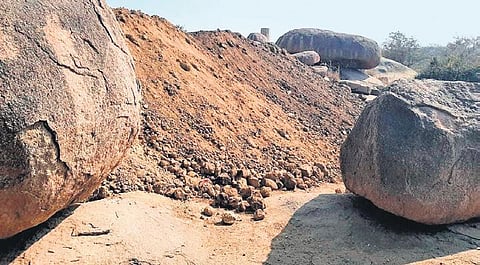

HYDERABAD: While the deliberate and methodical burying of Khajaguda rocks continues with lorries day in and day out dumping loose soil to cover the rocks, experts point out the area has the only large and outwardly visible remnant of the oldest form of rocks in Hyderabad, making the site even more important due to its pre-historic heritage.
These rocks, formed of gneissic granite, likely formed right after the Earth’s crust took shape. “Earth’s crust was formed some 250 crore years ago and it’s likely that these rocks formed just after that. Usually, such granite is extremely hard and act as a base rock with newer rocks of a basaltic kind etc forming over it, but in Khajaguda they stand exposed,” stated a senior geologist who used to work with the government.
It is this prehistoric heritage that makes the area unique.
What makes this entire site of 180 acres even more significant is that it has nearly 20 kinds of ‘erosional geological formations’ or shapes and forms that the rocks took which has been a subject of study for ecology students from various educational institutions, including TISS and Hyderabad Urban Labs.
According to experts, these 20 forms are boulders, castle koppies, nubbins, inselberg, peneplains, kluftkarren, corestones, pans, fracture valley, runnels, balancing rocks, pseudobedding, pits, tafoni, plinths, rock doughnuts, caves, splits and wedges, and chaos. These forms attract trekkers and nature enthusiasts every weekend.
Among these 20 forms, caves are one of the unique formations as it is usually rare for gneissic rock to form caves due to its hardness. However, in Khajaguda, some have formed in the underground and surface-level openings that regulate the water and light inside.
“To find all these kinds of geological formations in a single place in Hyderabad is what makes this place worthy. It’s a heritage site that needs to be protected. Not only do these rocks exist in these forms, but they also support various flora and fauna which has been a subject of study for many students,” explained Arun Vassireddy, an ecologist who has been working on these rocks for years.
Meanwhile, with such unregulated disruptions occurring frequently, experts note that the city itself would lose its landscape and identity. “These rock formations are just 5 km from the Musi and possibly a site where pre-historic populations lived. While there is no art and paintings from those times to be found here, it is highly likely that the shelter rocks and forests here once supported life, making it important to retain it to define the city’s identity,” said Vemuganti Murali, an expert on rock paintings.